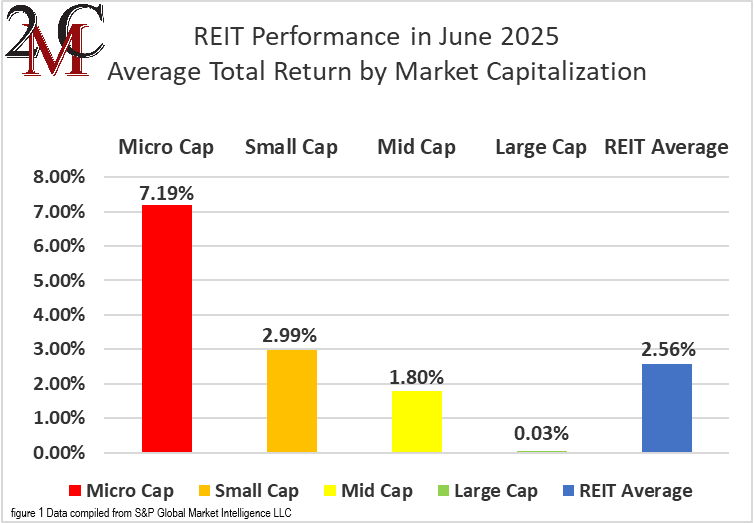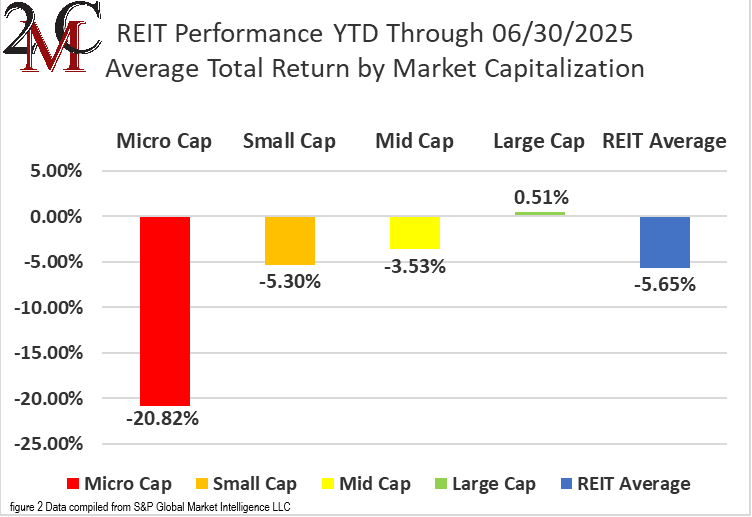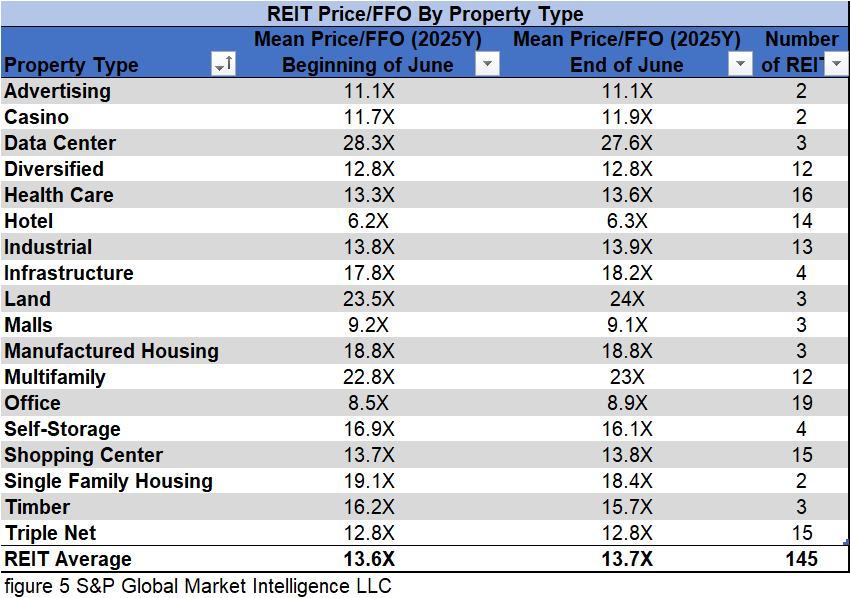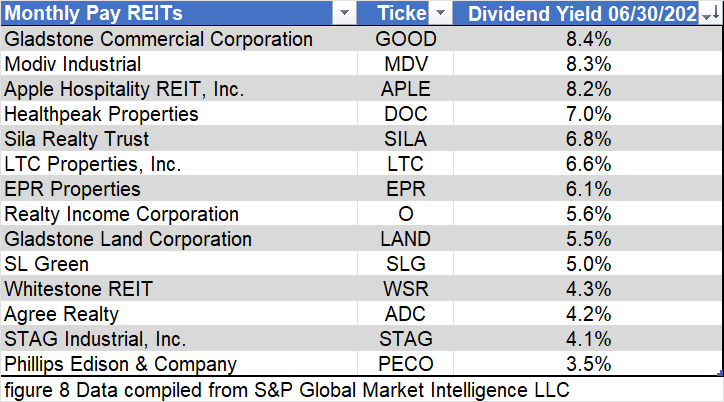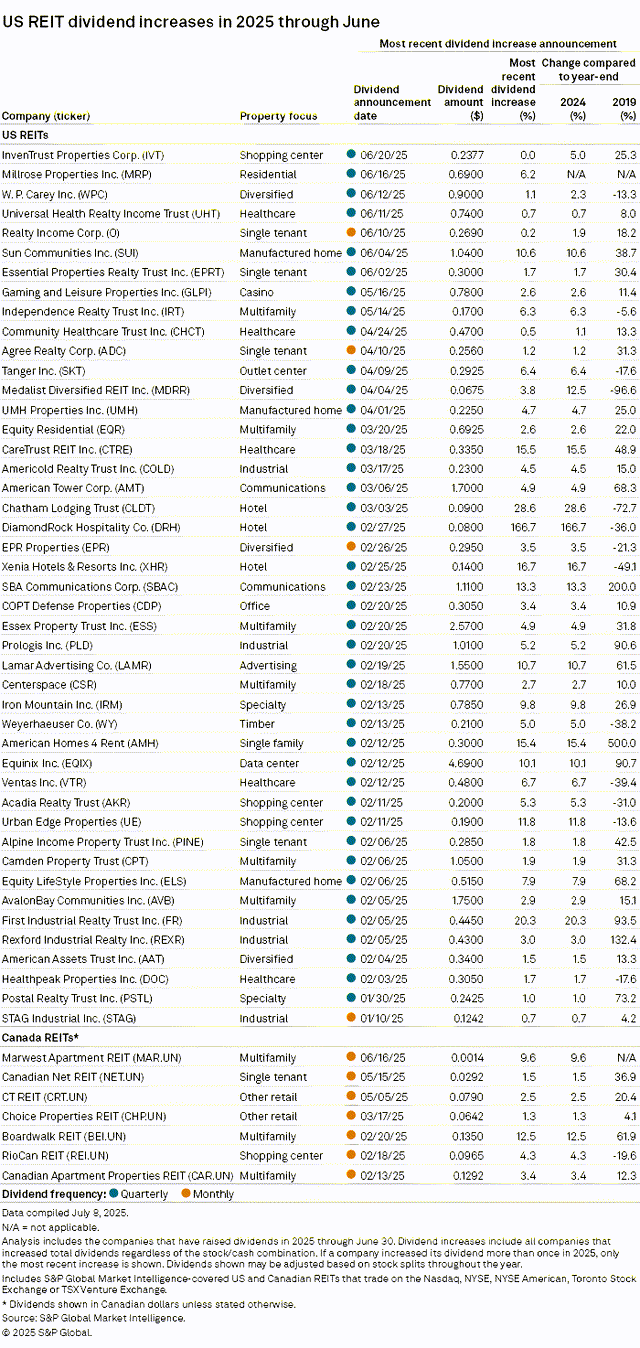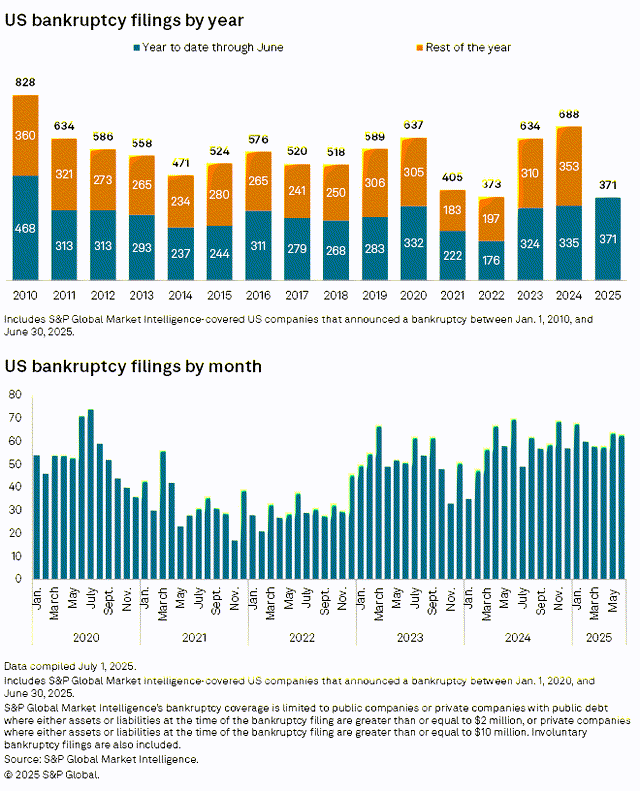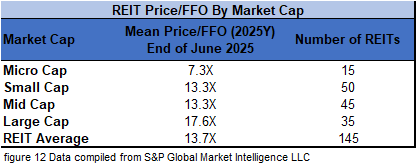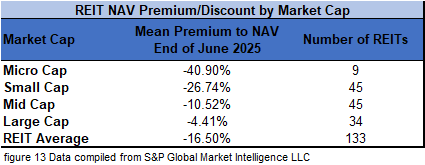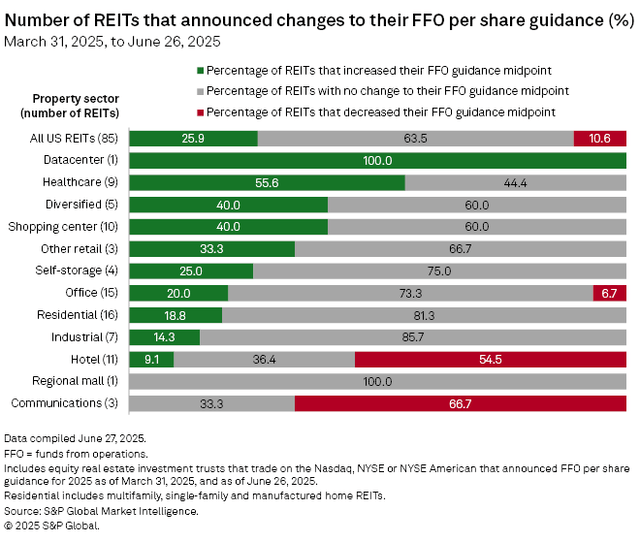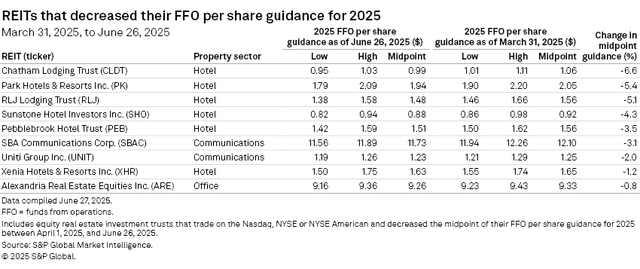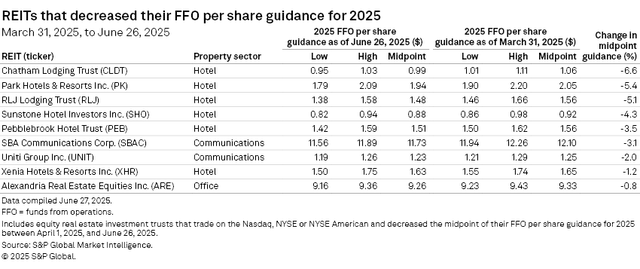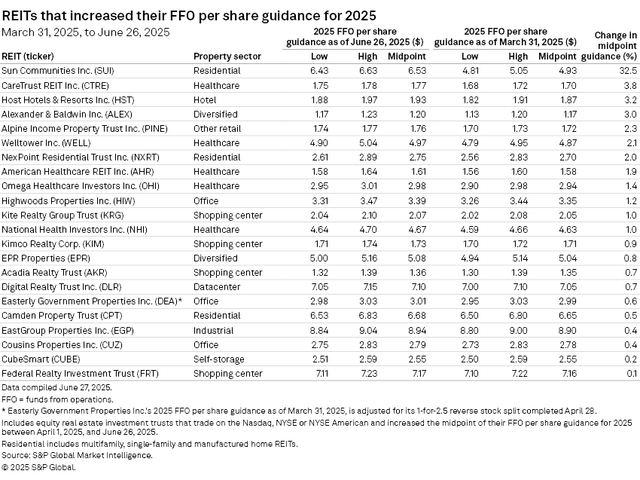The State of REITs: July 2025 Edition
- REITs had another month of recovery in June (+2.56% average total return), but despite back-to-back gains remain in negative territory YTD (-5.65%).
- Micro cap REITs (+7.19%) outperformed for the first time this year in June, while small caps (+2.99%), mid caps (+1.80%) and large caps (+0.03%) saw smaller gains.
- 87% of REIT securities had a positive total return in June.
- 72% of REIT property types averaged a positive total return in June. Self Storage (-3.47%) and Timber REITs (-2.49%) performed poorly, while Office (+7.60%) and Single Family Housing REITs (+5.60%) saw the biggest average gains.
- The average REIT NAV discount narrowed from -17.89% to -16.36% during June. The median NAV discount also narrowed from -20.32% to -19.68%.
REIT Performance
In June, REITs continued to recover with a +2.56% average total return. However, the REIT sector again lagged the gains of the broader market with stronger performances from the NASDAQ (+6.6%), S&P 500 (+5.1%) and Dow Jones Industrial Average (+4.5%). The market cap weighted Vanguard Real Estate ETF (VNQ) underperformed the average REIT again in June (+0.69% vs. +2.56%), but has significantly outperformed year-to-date (+2.01% vs. -5.65%). The spread between the 2025 FFO multiples of large cap REITs (17.6x) and small cap REITs (13.3x) narrowed in June as multiples contracted 0.2 turns for large caps but expanded 0.4 turns for small caps. Investors currently need to pay an average of 32.3% more for each dollar of FFO from large cap REITs relative to small cap REITs. In this monthly publication, I will provide REIT data on numerous metrics to help readers identify which property types and individual securities currently offer the best opportunities to achieve their investment goals.
After underperforming in each of the first 5 months of 2025, micro cap REITs (+7.19%) solidly outperformed their larger peers in June. Small caps (+2.99%), mid caps (+1.80%), and large caps (+0.03%) saw smaller gains. During the first half of 2025, large cap REITs have outperformed small caps by 581 basis points.
13 out of 18 Property Types Averaged Positive Returns in June
72.22% of REIT property types averaged a positive total return in June. There was an 11.07% total return spread between the best and worst performing property types. Office (+7.60%) and Single Family Housing (+5.60%) outperformed all other property types in June. Self-Storage (-3.47%) and Timber REITs (-2.49%) were the worst performing REIT property types.
Hotel (-15.35%), Office (-15.27%) and Shopping Center REITs (-13.66%) struggled over the first half of 2025 with double-digit average declines. Health Care (+8.98%) and Casinos (+7.35%) were the top performers over the first half of the year.
The REIT sector as a whole saw the average P/FFO (2025Y) increase 0.1 turns in June from 13.6x up to 13.7x. 50% of property types averaged multiple expansion, 27.8% averaged multiple contraction and 22.2% saw multiples hold steady in June. Data Centers (27.6x), Land (24x), Multifamily (23x), Manufactured Housing (18.8x) and Single Family Housing (18.4x) currently trade at the highest average multiples among REIT property types. Hotels (6.3x), Office (8.9x) and Malls (9.1x) are the only property types that average single digit FFO multiples.
Performance of Individual Securities
Although Wheeler REIT (WHLR) (+52.26%) led the REIT sector in June, this dead cat bounce did little to offset the share price collapse over the first 5 months of the year. Over the first half of 2025, Wheeler’s total return was the worst in the REIT sector with a tragic -98.72%. This continues a multi-year freefall in which Wheeler has consistently severely underperformed.
Presidio Property Trust (SQFT) (-11.36%) continues to struggle and closed out the first half of the year with a -34.62% year-to-date total return. Presidio had fallen out of compliance with NASDAQ’s rule pertaining to the $1.00 minimum bid price requirement, but managed to regain compliance on June 2nd, 2025 via a 1-for-10 reverse stock split.
63.87% of REITs had a positive total return in June. REITs have averaged a -5.65% year-to-date total return in 2025, which is slightly worse than the -3.86% return for the REIT sector over the first half of 2024.
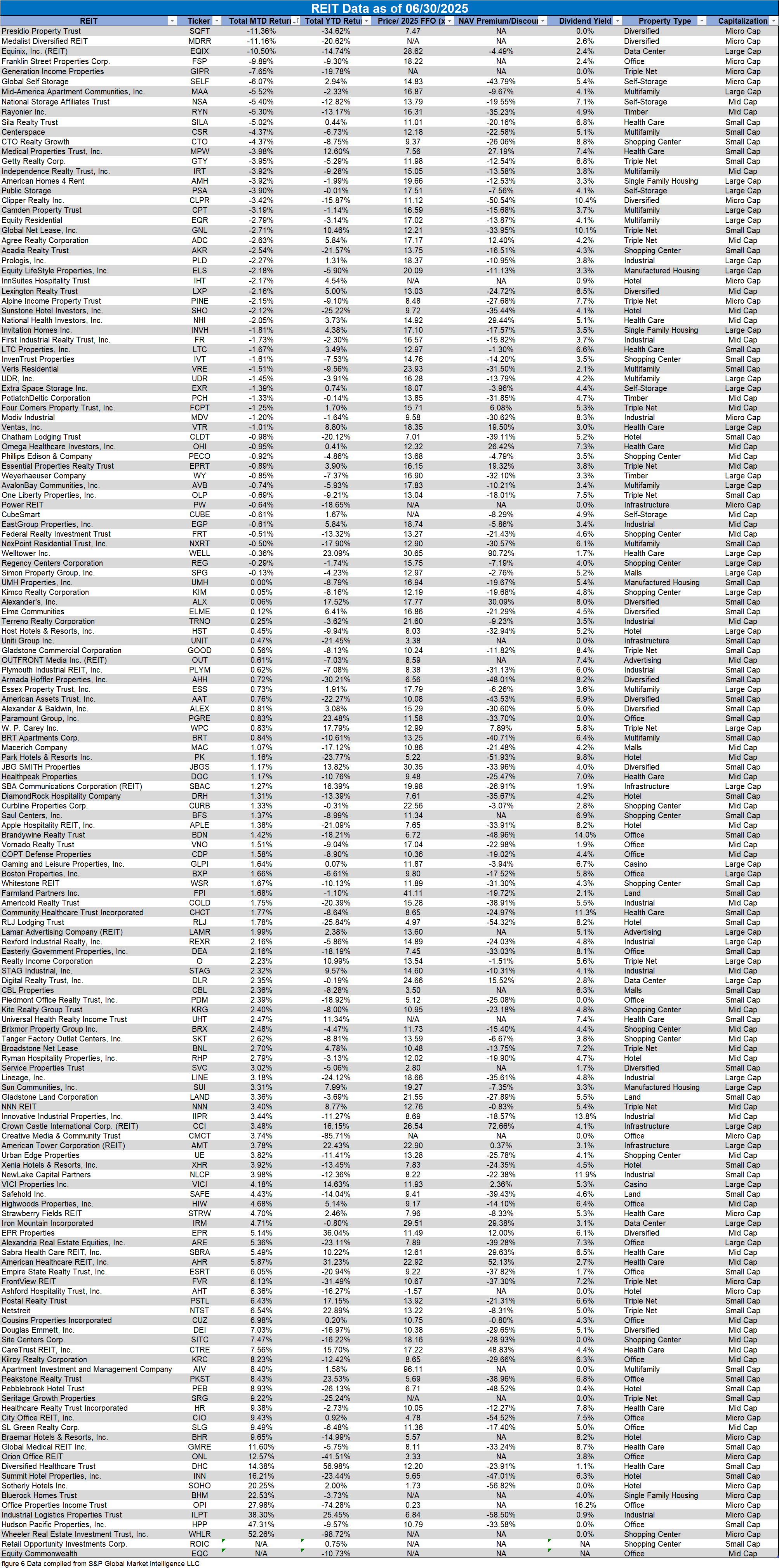
Dividend Yield
Dividend yield is an important component of a REIT’s total return. The particularly high dividend yields of the REIT sector are, for many investors, the primary reason for investment in this sector. As many REITs are currently trading at share prices well below their NAV, yields are currently quite high for many REITs within the sector. Although a particularly high yield for a REIT may sometimes reflect a disproportionately high risk, there exist opportunities in some cases to capitalize on dividend yields that are sufficiently attractive to justify the underlying risks of the investment. I have included below a table ranking equity REITs from highest dividend yield (as of 6/30/2025) to lowest dividend yield.

Although a REIT’s decision regarding whether to pay a quarterly dividend or a monthly dividend does not reflect on the quality of the company’s fundamentals or operations, a monthly dividend allows for smoother cash flow to the investor. Below is a list of equity REITs that pay monthly dividends ranked from highest yield to lowest yield.
Economic Health
The number of corporate bankruptcies decreased slightly month-over-month but remained elevated in June. There were more filings year-to-date in 2025 than in the first 6 months of any other year since 2010. There have been 10.7% more bankruptcy filings over the first half of 2025 than during the same period in 2024.
Valuation
REIT Premium/Discount to NAV by Property Type
Below is a downloadable data table, which ranks REITs within each property type from the largest discount to the largest premium to NAV. The consensus NAV used for this table is the average of analyst NAV estimates for each REIT. Both the NAV and the share price will change over time, so I will continue to include this table in upcoming issues of The State of REITs with updated consensus NAV estimates for each REIT for which such an estimate is available.
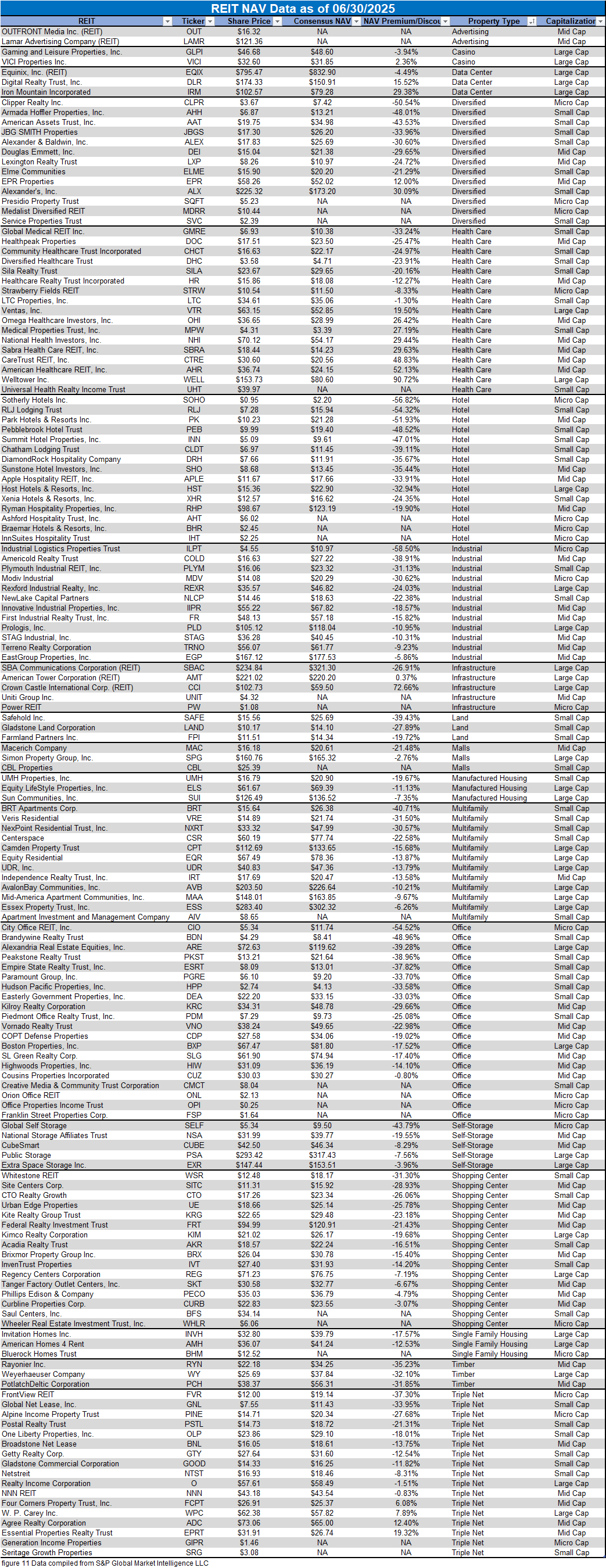
Takeaway
The large cap REIT premium (relative to small cap REITs) narrowed in June and investors are now paying on average about 32% more for each dollar of 2025 FFO/share to buy large cap REITs than small cap REITs (17.6x/13.3x – 1 = 32.3%). As can be seen in the table below, there is presently a strong positive correlation between market cap and FFO multiple.
The table below shows the average NAV premium/discount of REITs of each market cap bucket. This data, much like the data for price/FFO, shows a strong, positive correlation between market cap and Price/NAV. The average large cap REIT (-4.41%) trades at a single-digit discount to consensus NAV and mid cap REITs (-10.52%) trade at a low double-digit discount. Small cap REITs (-26.74%) trade at just under 3/4 of NAV while micro caps (-40.90%) trade at only about 3/5 of their respective NAVs.
71% of FFO Per Share Guidance Midpoint Adjustments Announced During the 2nd Quarter Were Upward Revisions
Among REITS that provided 2025 FFO per share guidance, 63.5% did not announce a change to their FFO per share guidance midpoint during Q2 2025. Among the 36.5% that did, however, 71% raised guidance while only 29% revised downward.
Downward revisions came overwhelmingly out of the Hotel and Communications sectors. The largest FFO per share guidance cuts came from Chatham Lodging Trust (CLDT) (-6.6%), Park Hotels & Resorts (PK) (-5.4%) and RLJ Lodging Trust (RLJ) (-5.1%).
By far the largest FFO per share guidance midpoint hike came from Sun Communities (SUI) (+32.5%). However, this is somewhat misleading due to the fact that the initially announced core FFO per share guidance did not include FFO from the marina portfolio that SUI would exit in a massive $5.65 billion transaction. SUI stated for illustrative purposes that if the FFO from the marina portfolio had been included in the initial 2025 core FFO guidance, then the range would have been between $6.82 and $7.06 with a midpoint of $6.94. Considering this, full year 2025 guidance was effectively revised downward (-5.9%) when inclusive of the transaction.
Excluding SUI, the largest guidance increases came from CareTrust REIT (CTRE) (+3.8%), Host Hotels & Resorts (HST) (+3.2%), and Alexander & Baldwin (ALEX) (+3.0%). HOST was the only Hotel REIT to raise full year 2025 FFO per share guidance during Q2, while 6 of their Hotel REIT peers revised downward.
S&P Global Market Intelligence has forecasted dividend hikes for 18 equity REITs, 16 of which are paid quarterly and 2 of which are paid monthly. They forecast that the largest dividend increases during Q3 2025 will come from RLJ Lodging Trust (RLJ) (+13.3%), Alexander & Baldwin (ALEX) (+11.1%) and Welltower (WELL) (+9.0%).
Well-managed REITs are often able to increase their dividend distributions to shareholders over time and are sometimes even obligated to do so due to REIT structure rules pertaining to dividend distribution of taxable income. With rising FFO/share and dividend increases across much of the REIT sector, many REITs are well positioned for a strong total return performance over the remainder of the year.
Important Notes and Disclosure
All articles are published and provided as an information source for investors capable of making their own investment decisions. None of the information offered should be construed to be advice or a recommendation that any particular security, portfolio of securities, transaction, or investment strategy is suitable for any specific person. The information offered is impersonal and not tailored to the investment needs of any specific person.
We cannot determine whether the content of any article or recommendation is appropriate for any specific person. Readers should contact their financial professional to discuss the suitability of any of the strategies or holdings before implementation in their portfolio. Research and information are provided for informational purposes only and are not intended for trading purposes. NEVER make an investment decision based solely on the information provided in our articles.
We may hold, purchase, or sell positions in securities mentioned in our articles and will not disclose this information to subscribers, nor the time the positions in the securities were acquired. We may liquidate shares in profiled companies at any time without notice. We may also take positions inconsistent with the information and views expressed on our website.
We routinely own and trade the same securities purchased or sold for advisory clients of 2MCAC. This circumstance is communicated to our clients on an ongoing basis. As fiduciaries, we prioritize our clients’ interests above those of our corporate and personal accounts to avoid conflict and adverse selection in trading these commonly held interests.
Past performance does not guarantee future results. Investing in publicly held securities is speculative and involves risk, including the possible loss of principal. Historical returns should not be used as the primary basis for investment decisions. Although the statements of fact and data in this report have been obtained from sources believed to be reliable, 2MCAC does not guarantee their accuracy and assumes no liability or responsibility for any omissions/errors
Commentary may contain forward-looking statements that are by definition uncertain. Actual results may differ materially from our forecasts or estimations, and 2MCAC and its affiliates cannot be held liable for the use of and reliance upon the opinions, estimates, forecasts, and findings in this article.
Through October 2021, The State of REITs was published exclusively on Seeking Alpha by Simon Bowler, Sector Analyst at 2nd Market Capital Services Corporation (2MCSC). Editions subsequent to October 2021 will be published on this website in addition to other platforms that may include Seeking Alpha. 2MCSC was formed in 1989 and provides investment research and consulting services to the financial services industry and the financial media. 2MCSC does not provide investment advice. 2MCSC is a separate entity but related under common ownership to 2nd Market Capital Advisory (2MCAC), a Wisconsin registered investment advisor. Simon Bowler is an investment advisor representative of 2MCAC. Any positive comments made by others should not be construed as an endorsement of the author's abilities to act as an investment advisor.
S&P disclosure: S&P Global Market Intelligence LLC. Contains copyrighted material distributed under license from S&P.
Discover more from 2nd Market Capital Advisory Corp
Subscribe to get the latest posts sent to your email.
